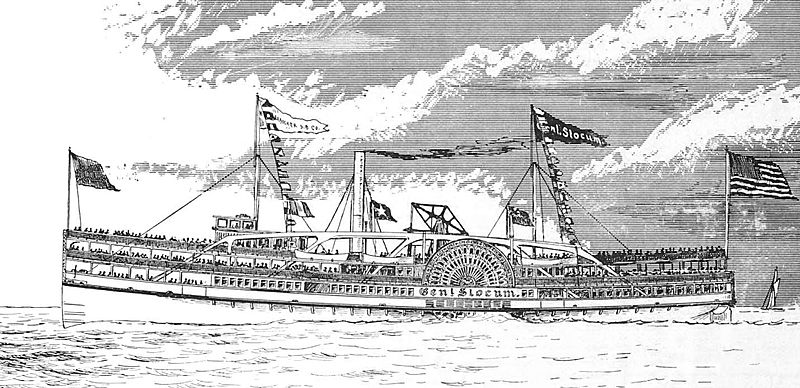On June 15th, 1904 the PS General Slocum was chartered by St. Mark’s Evangelical Lutheran Church of New York City for $350. 1,360 people showed up that Wednesday for the 17th annual Sunday School picnic. It was a calm and beautiful morning… anyone who has visited Manhattan in the summer can envision this morning. The sun warming away cool breezes, the river waves slapping the dock, and building excitement as people arrived for a fun day.
Even by today’s standards… a church event with 1,360 people is a really, really big deal.
The plan was to take a ride around Manhattan before docking at a picnic area in the Bronx, Locus Point. Hundreds of excited children and teachers had the run of the ship. You can imagine there was a mix of order and chaos with some children on their best behavior while others, not with their parents, acted mischievously… poking around where they weren’t allowed and causing the crew to have headaches.
About 30 minutes into the cruise, between 83rd Street and 90th Street people began to report a fire aboard the boat. One child told reported the problem to the captain but was told to “Shut up and mind your own business.” Initial reports of the fire were largely ignored by the crew… which only allowed it to build.
When the inferno grew, the crew scurried to the fire hoses. But the crew had never had a fire drill, never tested the hoses, or knew how to properly put out the fire. Consequently it was not surprisingly they didn’t work.
The fire turned into a blaze as it spread through the mostly wooden ship. The fire was fueled as it reached various compartments where flammable paint and gasoline were stored.
Soon it became clear that this was a dire emergency.
The captain could have steered the boat to the port side (left) and docked along an industrial area where the fire department could have come and helped him put out the fire. But the captain was worried that the docks may catch fire, too. So he instead steered the boat at full speed across the East River, hoping to run aground on North Brother Island.
Unfortunately, heading at full speed against the wind merely fanned the flames and put them in more immediate danger.

Passengers found the life preservers. But they hadn’t been inspected since the boat was built in 1891 and been stored outdoors the whole time. Over the years the cork-filled preservers had either dry rotted or completely fallen apart. Panicked mothers put them on their children and dropped them into the water only to watch in horror as the mixture of their heavy wool clothes and rotten preservers caused their children to sink to the bottom immediately. This merely multiplied the panic… but the crew was no where to be found.
There were lifeboats aboard. But they were mostly for decoration as the chains were so tight & painted that no one could free them. Worthless, panic compounded.
Finally, the captain ran the boat ashore. But he missed the sandy area of the island and instead guided the boat into the rocks. They’d have to swim for it… which was a problem since most people didn’t know how to swim.
By this time total calamity befell the passengers. Those who stayed on board were burned to death. Those who jumped either couldn’t swim, were drown by their life preservers, or sank on their own when their wool clothes weighed them down.
In the end, 1,021 passengers died that day. It’s the worst maritime disaster in the history of New York. Prior to September 11th, 2001 it was the worst loss of life experienced in the city.
The Aftermath
1,021 dead mothers and children fundamentally changed our society. The government investigation revealed that such companies routinely put profits over passenger safety.
Consequently, the General Slocum disaster lead to massive passenger safety regulations that we all take for granted today. Boats are regularly inspected. Companies are held responsible for regular safety drills. Fire equipment must work and there have to be back-ups. Passengers are informed of safety procedures before every departure. Life-preservers are inspected and have expiration dates. Lifeboats have to actually work. Radio equipment must be on board to communicate directly with the coast guard. On and on the list goes.
On June 15th, 1904 1,021 people needlessly died. But millions of lives have been potentially saved as a direct result of the public outcry after the disaster.
We are safer today because early in the 20th century we allowed a disaster to change us as a society, we enacted laws and regulations that an industry didn’t initially want in place.
Together we said, “Never again will our children drown because of faulty safety equipment.”
We stood up to an industry that put its profits above public safety. And we are all better for it.
This Tragedy Has Changed Us
Perhaps, dear friends, we need to follow in our forefathers footsteps?
sources: History.com, Wikipedia


Leave a Reply